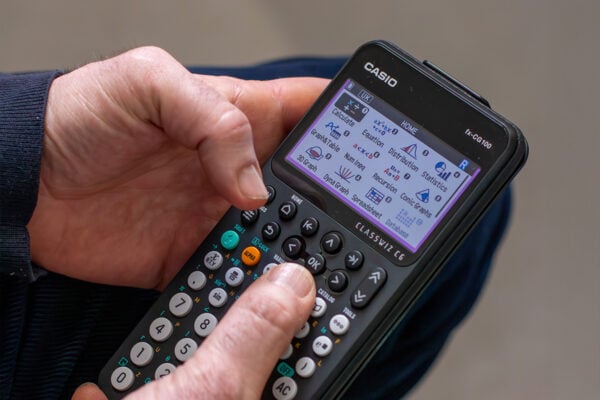4 of the many wonderful ways to use a scientific calculator

Our ClassWiz scientific calculator range comprises the entry-level fx-83GT CW and fx-85GT CW models and the more advanced fx-991CW. While there are differences in functionality between the fx-83/85 and the fx-991, all calculators in our ClassWiz range share features including:
- A simple key layout with home, back, cursor and OK keys
- An intuitive and easily navigable menu
- Rounded keys and a textured side-grip
Seeing as the details of what you can do on our scientific calculators vary slightly between models, we wanted to provide four specific examples of how you can use them in the classroom. The first two apply to the fx-83/85 and points three and four relate to the fx-991.
1. Showing inequalities on a number line
Our entry-level calculators offer a number line feature that you can use to display and explore inequalities in your maths lessons. This can be an effective way to increase engagement with the topic and give students a simple visual representation of values that are less than, equal to or greater than the values given in a question.
You can display inequalities individually or present up to three at one time alongside each other.

The number line feature is part of the Math Box app, where you can also run dice-roll and coin-toss probability simulations and explore angles and trigonometric values using a clock face .
2. Finding common factors and multiples
Working out the highest common factors and lowest common multiples of given numbers is something students can do quickly and easily on the Casio fx-83/85, thanks to recent improvements to our ClassWiz calculators.
When you open the Catalog menu on the calculator you will see various options, including the Numeric Calc sub-menu. This is where you can access the highest common factor (or greatest common divisor) and lowest common multiple tools.
After opening the one you need, it’s a simple task of entering the relevant values to find their highest common factor or lowest common multiple.
[1] 1 shows the number lines of the equations or inequalities in lines A, B and C; 2 shows the x axis with centre and either end values; 3 shows the equations or inequalities of the currently selected number line

Once you feel confident that your students have grasped the basic theory underlying this topic, these tools can be highly effective in enabling quicker, more efficient working.
3. Solving equations
Moving on to some of the more advanced functionality of the fx-991CW, one of the most useful aspects of this calculator is the Solver function in equation mode, which you can use to solve simultaneous, polynomial and other equations.
Accessed via the Equation app on your calculator’s home screen, the Solver functionality lets you input the values relevant to your question and get an instant solution to the equation.

In calculation mode, entering x can also display the value as a fraction.

[1] 1 shows the variable solved for; 2 shows the solution; 3 shows the left side/right side result[1] 1 shows the distribution calculation type; 2 shows the value at the current cursor position; 3
Year 10 and 11 students preparing for their GCSE maths exams could find this particularly useful for reinforcing their knowledge when revising and checking their answers during examinations.
4. Introducing probability distributions
Another feature that distinguishes the fx-991 from the fx-83/85 is its ability to work with probability distributions – specifically normal, binomial and Poisson distributions.
You can access the Distribution app from the calculator’s home screen and select your calculation type and data input method, before entering your chosen parameters to get your range of probabilities.

This can be a highly engaging way to introduce students to what can, at first, appear to be a complicated topic.
When A-level students come to study statistics, they could benefit from the advanced functionality of the fx-CG50 graphing calculator to explore probability distributions in more depth. The fx-CG50’s Distribution app lets you calculate normal, binomial, Poisson and t-distributions between values, and also go a step further and visualise both discrete and continuous distributions graphically.
[1] 1 shows the distribution calculation type; 2 shows the value at the current cursor position; 3 shows the data (x); 4 shows the calculation results (P)
Learn more about scientific calculators
Interested in learning more about the many potential applications of scientific calculators? You can find plenty of information in our resources centre, including model-specific ‘how to’ guides, videos, leaflets and more.
We’re also more than happy to answer your questions and discuss your school’s unique priorities and technology requirements.
Just contact us to get the conversation started.



